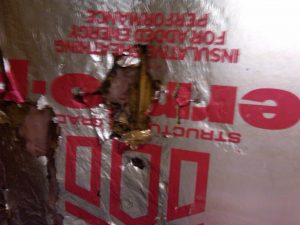When you think about termites and why they would be attracted to your home you ultimately come up with a list of conducive conditions. Leaking water spigots, cracks in the foundation, stored wood piles right next to the house and the list goes on and on. While it’s great to realize these areas could be a problem and even better to correct them there is an area most people don’t think twice about but one where I find a large percentage of termite activity and damage. Not every home has an attached shed but typically they are on mobile homes or houses with carports. These handy add ons give us space to keep our tools or have the washer and dryer but unfortunately they also give the subterranean termite easy access to the main structure, your home.
Now before I go on, it’s sort of a misnomer that anything can attract termites. Being blind the subterranean termite doesn’t see the lights on at your home and decide to attack. Their foraging patterns are pretty sophisticated however and when they key in on certain clues, they explore that area with a fine tooth comb and if they can get in they call in the calvary and the feast is on.
3 major problems with attached sheds
Number 1 is we pack our sheds with tons o stuff! It’s really difficult to see anything termite wise because of all the tools, storage, shelves etc. Termites can go a long time without being noticed and since the bldg. is attached they often find their way into the house.
the house.
Number 2 A lot of sheds have insulation on the walls covering the studs and the siding from the floor to the ceiling. I don’t know why most have this because they’re not heated and cooled but I see it all the time. So even an empty shed provides very little visible help when looking for the secretive termite. What’s worse is most of the insulation that’s used is a cellulose material, a kind of pressed board. Wood is cellulose so this insulation is like a candy treat they can gobble up quickly.
Number 3 the exterior siding is almost always right to the grade level or below. Talk about a perfect scenario, the termite now has a protected entry and since there is no space where the wall can breathe it holds in more moisture that they have to have in order to survive. This also makes it very difficult to see any mud tubes or evidence of the invading pest so again they may go un-noticed for far to long.
What to look for and what to do
Termites move up and down in mud tunnels and at times you can see the tube on a stud or across the insulation. They live in seclusion and do not expose themselves so they usually eat just to the outer edge of the wood they’re eating. If they are in the insulation you’ll see that the plastic or last paper layer becomes wrinkled or bubbled and with a little poking you’ll uncover the damage just beneath the surface. Sheds are also a common place for swarms and you may find wings on the shelving or widow sill. Also tubes on the exterior foundation may be visible if it’s not at ground level.
 The best way to keep termites out of your attached shed is of course to have it treated before they get in but you still may need some modification. Siding below grade not only keeps the entry secretive but it can block a liquid termite barrier from getting where it needs to go. I advise my clients to either cut the siding for clearance or to dig some of the dirt away so you can at least see the foundation. Also if there are any expansion joints or cracks in the cement those areas need to be drilled and termiticide should be injected in the soil below. Remember, termites only need 1/64th of an inch to get in so this is very important. If you do have a utility sink or washer in your shed make sure you don’t have any leaks and that the water drains away from the shed. (preferably in proper plumbing and not just out on the lawn) Of course not packing the inside and keeping some of the wall space visible would be great but I realize that’s not always available. A termite inspection by a professional is always a good idea but keeping a vigilant eye out in between may save you from some costly surprises.
The best way to keep termites out of your attached shed is of course to have it treated before they get in but you still may need some modification. Siding below grade not only keeps the entry secretive but it can block a liquid termite barrier from getting where it needs to go. I advise my clients to either cut the siding for clearance or to dig some of the dirt away so you can at least see the foundation. Also if there are any expansion joints or cracks in the cement those areas need to be drilled and termiticide should be injected in the soil below. Remember, termites only need 1/64th of an inch to get in so this is very important. If you do have a utility sink or washer in your shed make sure you don’t have any leaks and that the water drains away from the shed. (preferably in proper plumbing and not just out on the lawn) Of course not packing the inside and keeping some of the wall space visible would be great but I realize that’s not always available. A termite inspection by a professional is always a good idea but keeping a vigilant eye out in between may save you from some costly surprises.




